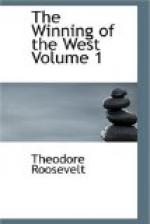Each family did every thing that could be done for itself. The father and sons worked with axe, hoe, and sickle. Almost every house contained a loom, and almost every woman was a weaver. Linsey-woolsey, made from flax grown near the cabin, and of wool from the backs of the few sheep, was the warmest and most substantial cloth; and when the flax crop failed and the flocks were destroyed by wolves, the children had but scanty covering to hide their nakedness. The man tanned the buckskin, the woman was tailor and shoemaker, and made the deerskin sifters to be used instead of bolting-cloths. There were a few pewter spoons in use; but the table furniture consisted mainly of hand-made trenchers, platters, noggins, and bowls. The cradle was of peeled hickory bark.[41] Ploughshares had to be imported, but harrows and sleds were made without difficulty; and the cooper work was well done. Chaff beds were thrown on the floor of the loft, if the house-owner was well off. Each cabin had a hand-mill and a hominy block; the last was borrowed from the Indians, and was only a large block of wood, with a hole burned in the top, as a mortar, where the pestle was worked. If there were any sugar maples accessible, they were tapped every year.
But some articles, especially salt and iron, could not be produced in the backwoods. In order to get them each family collected during the year all the furs possible, these being valuable and yet easily carried on pack-horses, the sole means of transport. Then, after seeding time, in the fall, the people of a neighborhood ordinarily joined in sending down a train of peltry-laden pack-horses to some large sea-coast or tidal-river trading town, where their burdens were bartered for the needed iron and salt. The unshod horses all had bells hung round their neck; the clappers were stopped during the day, but when the train was halted for the night, and the horses were hobbled and turned loose, the bells were once more unstopped.[42] Several men accompanied each little caravan, and sometimes they drove with them steers and hogs to sell on the sea-coast. A bushel of alum salt was worth a good cow and calf, and as each of the poorly fed, undersized pack animals could carry but two bushels, the mountaineers prized it greatly, and instead of salting or pickling their venison, they jerked it, by drying it in the sun or smoking it over a fire.
The life of the backwoodsmen was one long struggle. The forest had to be felled, droughts, deep snows, freshets, cloudbursts, forest fires, and all the other dangers of a wilderness life faced. Swarms of deer-flies, mosquitoes, and midges rendered life a torment in the weeks of hot weather. Rattlesnakes and copperheads were very plentiful, and, the former especially, constant sources of danger and death. Wolves and bears were incessant and inveterate foes of the live stock, and the cougar or panther occasionally attacked man as well.[43] More terrible still, the wolves sometimes went mad, and the men who then encountered them were almost certain to be bitten and to die of hydrophobia.[44]




